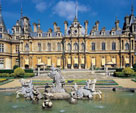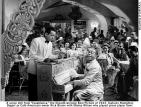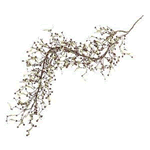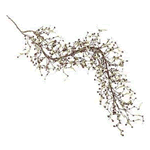|
 “The
appropriate penalty would be to pay me a stipend for life, to support
me in the criticism of individual citizens of Athens." “The
appropriate penalty would be to pay me a stipend for life, to support
me in the criticism of individual citizens of Athens."
THE WALLS
 The
main model for "Wallingham" is in Buckinghamshire, near Aylsbury,
"the last remaining example of le style Rothschild". Built
in 1874/89 by Baron Ferdinand de Rothschild, it was bequeathed to the
National Trust in 1957. Waddesdon Manor houses a superb collection of
Rennaissance art, eighteenth century furniture and Sevres porcelain
among its treasures, all lovingly tended by an army of domestics. Doesn't
look much like a red brick Gormenghast, no Yellow Drawing room, and
no Klimt hangings. You won't find much Art
Nouveau, either, it's more of a French 16th century chateau feel.
Awesome place. The
main model for "Wallingham" is in Buckinghamshire, near Aylsbury,
"the last remaining example of le style Rothschild". Built
in 1874/89 by Baron Ferdinand de Rothschild, it was bequeathed to the
National Trust in 1957. Waddesdon Manor houses a superb collection of
Rennaissance art, eighteenth century furniture and Sevres porcelain
among its treasures, all lovingly tended by an army of domestics. Doesn't
look much like a red brick Gormenghast, no Yellow Drawing room, and
no Klimt hangings. You won't find much Art
Nouveau, either, it's more of a French 16th century chateau feel.
Awesome place.
THE LAST LENNON TAPES
"On the 6th December 1980 John Lennon and his wife,
Yoko Ono, taped a three hour interview with Andy Peebles in New York for
BBC Radio One. It was the first time for over five years that John had
agreed to face a radio microphone. What was expected to be a routine half-hour
chat about his and Yoko's latest LP, Double Fantasy, turned magically
into a long, deep and candid discussion  about
his life and work..." I was looking for a way to treat the Keith
Utamore "Rick's place" interview, when I found this on the sofa
at Val and Dave's, next door, when we were babysitting one night. What
a masterly interviewer! Fascinating transcript, intimate and unpremeditated. about
his life and work..." I was looking for a way to treat the Keith
Utamore "Rick's place" interview, when I found this on the sofa
at Val and Dave's, next door, when we were babysitting one night. What
a masterly interviewer! Fascinating transcript, intimate and unpremeditated.
RICK'S PLACE

"Casablanca" premiered in New York in November
1942. "Rick's Place" aka Rick's Cafe American, subsequently
became the WWII code name for the city of Casablanca, (it says here...)
BUSTED BY THE SCOTS
 Either dux bellorum or a piece of currency to be passed from hand to hand...
If you must be king of England, don't end up depending on the Scots
to bust you out of jail, or set you back on the throne. Our friends in
the north
Either dux bellorum or a piece of currency to be passed from hand to hand...
If you must be king of England, don't end up depending on the Scots
to bust you out of jail, or set you back on the throne. Our friends in
the north  drove a very hard bargain, not only with Charles I (admittedly, he asked
for it) but with his son (the lad could have packed it all in and earned
good money as a mercenary, but you don't think like that when the God
game's got you in its sway). See The Tragedy of Charles II, Hester Chapman.
For details of the part played by Highlanders I'm indebted to Mr Lyell
Drummond, and "Highland Warrior" by David Stevenson.
drove a very hard bargain, not only with Charles I (admittedly, he asked
for it) but with his son (the lad could have packed it all in and earned
good money as a mercenary, but you don't think like that when the God
game's got you in its sway). See The Tragedy of Charles II, Hester Chapman.
For details of the part played by Highlanders I'm indebted to Mr Lyell
Drummond, and "Highland Warrior" by David Stevenson.
|
|
IMPRISONED BY THE BRITISH
Stephen Of Blois,
captured at the Battle of Lincoln, 1141. imprisoned in Bristol Castle,
traded for the Earl of Gloucester, November of the same year.
Matilda, Henry I's legitimate
heir, fought a civil war with Stephen, during which she once  escaped
from Devizes disguised as a corpse. In 1142 she left Oxford Castle,
lowered from the castle walls by rope and made her escape across the
frozen Thames (little ice age) escaped
from Devizes disguised as a corpse. In 1142 she left Oxford Castle,
lowered from the castle walls by rope and made her escape across the
frozen Thames (little ice age)
Richard I Kidnapped by the
Emperor of Austria on his way back from 3rd Crusade, redeemed by payment
of astronomical ransom.
Edward II We already dealt
with him.
Richard II Is the one who
sat upon the ground and told sad stories of the death of kings, etc,
in the play of same name. He may look soft and cute in the National
Gallery but he was a twister who put down the Peasants' Revolt savagely.
He was starved to death in Pontefract Castle.
Henry VI Captured and imprisoned
twice in the first phase of the Wars of the Roses, murdered in the Tower
1470.
Edward V One of the Princes
in the Tower. Vanished in the shuffle, most likely killed on orders
of his uncle Richard III
Lady Jane Grey Executed
in the Tower of London after a reign of 9 days, aged 17
Mary Tudor and her sister
Elizabeth I both spent their
teen years under virtual house arrest, more or less comfortably as their
father's marital fortunes changed.
Mary Queen of Scots spent
a lot of time imprisoned and plotting in England and Scotland, in various
stately homes. Her cousin Elizabeth finally had her killed.
Charles I Handed over to
parliamentary commissioners by his Scottish allies in 1647, he was later
held in Carisbrooke Castle on the Isle of Wight, (where he mislaid a
large diamond) then Hurst in Hampshire; still trying to cut a deal with
the Scots. He was moved to Windsor Castle, and beheaded Jan 1649
THE RULES OF POO-HEAD
  
The cards:
2 beats anything, starts numerical sequence again
3 is the lowest card
7 see-through (ie, next player has to respond to previous
played card)
8 next player misses a go (in a two hand game, the
eight can be used to allow for gaps in runs)
10 clears the table (discard stack set aside: whoever lays the
ten starts again).
The
deal:
Three cards are dealt to each player, face down. This is the underhand.
Three more cards are dealt, face up (the overhand); and then three cards
more.
The
play:
In the first phase each player may swap 0,1,2 or 3 of the cards in their
hand with the cards in their overhand.
Player
to dealer's left (or non-dealer in two hand game) is given first option
to discard a 3. If no player holds a 3, the player to dealer's left
lays their lowest card. Next player may discard the card (or cards)
next in numerical sequence, without limit (4x4, and 5x5 and 6x6 etc).
If the player doesn't hold a card of the right value, they must pick
up the discard stack, but 2, 7 or 10 may be laid at any time. A player
who successfully discards all their cards begins the endgame, laying
down first the overhand (in any sequence), then the underhand. First
player to have no cards wins, loser is the poo-head & deals the
next hand. Poo-head is the intellectual property of Jon and Pat Mayes,
1996.
|







 Either dux bellorum or a piece of currency to be passed from hand to hand...
If you must be king of England, don't end up depending on the Scots
to bust you out of jail, or set you back on the throne. Our friends in
the north
Either dux bellorum or a piece of currency to be passed from hand to hand...
If you must be king of England, don't end up depending on the Scots
to bust you out of jail, or set you back on the throne. Our friends in
the north 


